Introduction
Fresh water freezes at 0 degrees Celsius and expands by 9% with a significant force that will destroy:
- Pipework
- Boiler components
- Taps, and shower valves
Frost and Ice causes damage by two methods:
- Water freezing within the home in appliances, pipes taps or TMV valves
- Water pressure increasing within the entire system caused by water freezing in pipes outside of the home
We have decided to offer advice based on how the home is being used or when in the season you may need the advice:
- If you are leaving the home for the winter season and do not intend to return until the spring
- If you intend to use the home intermittently during winter
- If you intend to live full time in the home during winter
- Information/advice that is common to 1, 2 and 3 above
1. If you are leaving the home for the winter season and do not intend to return until the spring
If you leave fresh water in your caravan system over the winter you will run the risk of damage. This can only be avoided by removing the fresh water from the system – we call this a DRAIN DOWN You may wish to drain down the fresh water system yourself using the procedure in the next section but we STRONGLY RECOMMEND that you have this carried out by an experienced engineer as many caravan systems can only be completely drained by blowing the water out and this requires specialist equipment. View the £50-£60 charge for a drain down as a mini insurance policy and always ask the engineer if he has equipment to blow the water out and a refractometer to check the anti-freeze level. The two most common parts to be damaged by frost are the shower valve and the hydraulic assembly in a combi and the costs to replace these are around £100 and £300 respectively.
Drain Down Procedure
- Turn off the fresh water supply stop valve outside the Holiday Home
- Disconnect the fresh water feed outside the home if possible as this protects from flooding due to stop valve failure
- Open all hot and cold taps and shower valves and place the shower head in the tray
- Use the Holiday Home Owner’s Handbook to locate the fresh water drain cocks under the van
- Open these drain cocks – if you have a centrally heated home DO NOT open all the drain cocks directly under the combination boiler as this will drain the sealed heating system and this should be protected by antifreeze – see details in section 4 of this article “Information/advice that is common”.
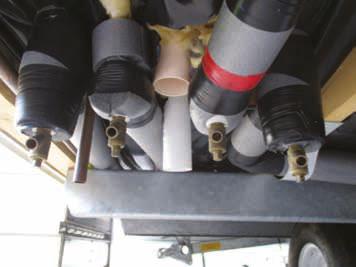
The above photo shows the plumbing under a home directly under a combination boiler. The two outer drain cocks are for the sealed central heating system and the two inner drain cocks are for the fresh water. Only open those for fresh water.
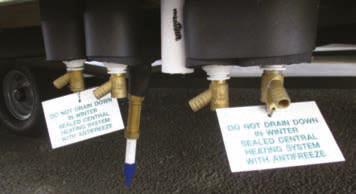
This manufacturer has helpfully labelled the central heating system drain cocks to avoid them being incorrectly used. You will notice that they are the outer two.
This procedure does not guarantee that all the fresh water will leave the system. Most modern homes have shower mixer valves that have double check valves fitted. These stop the flow of water around the system once the drain cocks and taps are open. It may appear that all the water has left the system, but beware! This pitfall can be avoided by removing the shower mixer valve/valves from the system after the cold water supply has been switched off and the drain cocks opened. Many manufacturers provide access panels and these may make the removal of shower mixers easier. Removal of some shower mixers requires the use of special tools.
In addition pipe work layouts can cause air locks leaving water inside vulnerable components such as the boiler.
Re-commissioning the home in spring is a reverse of the above.
2. If you intend to use the home intermittently during winter
This is the most difficult to advise on as the only risk free solution is to have an engineer drain down your home every time you leave the park. We appreciate this is an expensive approach but it is the only one that is failsafe. You can choose to turn off the cold water supply and carry out your own drain down without blowing the cold water through the pipes. You can also remove the shower mixer valves, leave electric power and a gas supply to the boiler so that the boiler frost protection works. All these will help to avoid damage but they will not guarantee that no damage will occur. In the case of the boiler frost protection it will not protect the radiators or the all-important hot/cold circuit – it is only designed to protect the heating part of the boiler which, in any event, should be full of antifreeze/corrosion inhibitor and so not in need of protection. (See boiler frost protection in section 4).
3. If you intend to live full-time in the home during winter
You may feel that your home is not at risk of frost related damage when you are using the home in this way but BEWARE. During the last winter Morco had many examples of boilers and mixer taps being damaged overnight even though the owners/customers were staying in the home and had the central heating on. This phenomenon has been known to Morco for some years but the lack of a really cold winter meant we never saw the theory in action with our current range of GB combi boilers. What actually happens is that the home, including the boiler cupboard, remains warm due to the central heating being on. Obviously no damage due to ice formation can occur in these circumstances. However, nearly all holiday homes have the hot and cold water pipes hung underneath the home. These pipes are lagged in line with the National Caravan Council standards but they will only protect the water within the pipes from freezing for a period of time in cold conditions. While the home owners are sleeping in a warm bed with the combi boiler circulating the antifreeze/water/corrosion inhibitor mix in the sealed heating circuit around the radiators, the mains water inside the hot and cold pipes under the home is turning to ice. This has the effect of compressing the water that is still unfrozen elsewhere in the system. This water may be in the pipes under the van, inside the boiler, in the pipes inside the home and in the shower mixers or mixer taps. As the ice continues to form, the pressure increases. Combi boilers are usually specified to cope with mains water pressures up to 10 bar, TMV2 shower mixers will generally be in trouble at pressures above 6 bar. The hot and cold water pipes under the typical home has a capacity of 3.6 litres. As ice forms, that volume increases to 3.925 litres and, as water is pretty much incompressible, this extra 0.325 litres needs to go somewhere. Depending on where the water turns to ice in the pipe, it may push apart a pipe fitting under the van or it may blow O ring seals out of the boiler hot/cold water components or cause irreparable internal damage to shower mixer valves.
The likely time line is as follows:
6pm – you watch Michael Fish inform you it is going to be a freezing night on the weather report.
10pm – you check the heating is set to keep the inside of the home warm all night.
3am – ice starts to form in the pipes under the home increasing the pressure in the unfrozen water inside the home.
4am – the pressure inside the mains water part of the warm combi boiler exceeds its 10 bar design specification. The shower mixers have already exceeded their 6 bar maximum and been damaged.
4.30am – the O ring seals in the boiler give way – minimal water leaves the boiler as the mains water supply to the home is frozen solid.
8.30am – you wake up after a warm night in bed and find that you cannot fill the kettle or take as shower as the pipes under the van are frozen. You look inside the boiler cupboard and utter a sigh of relief as there is no water on the floor and so assume no damage has occurred.
1pm – the bright sunny winter’s day causes the frozen water in the pipes under the home to thaw. The good news is that you can now fill the kettle, the bad news is that mains pressure water pours past the displaced and damaged O rings in the boiler, filling the boiler cupboard with water.
1.05pm – you hurry to turn the stop valve off to avoid further damage.
5pm – your engineer calls Morco from the home to be advised that the problem they are describing is frost damage and is therefore not covered by warranty.
5.01pm – the home owner understandably reacts with frustration and disbelief. Only when the whole process is explained do they start to understand that their unfortunate situation is due to frost.
3 days later – the boiler is now repaired – further frustration can occur when the water delivery for their first shower in days is luke warm and variable in delivery! The immediate conclusion is that the boiler is broken, again! In reality it is the internal damage caused to the shower mixer due to exceeding its operating pressure. This device will not leak water when damaged but will cause the hot water delivery at all showers and taps to be compromised until it is replaced.
Timing of Water Pressure Damage
There are 2 reasons why the problem is largely caused overnight:
- Temperatures are lower at night
- The hot and cold water outlets are not used as the owner and their family are asleep. Continually using hot and cold water during the day draws through the water that is about to freeze under the home and replaces it with water from pipes that are buried underground that may be 5-10°C warmer
Solutions to Water Pressure Damage
There are a number of solutions:
- The holiday home could have trace heating fitted to all 35-40m of hot and cold pipes under the home. This can often be specified when the home is being manufactured or retro-fitted at some cost on the park.
- Some lodges and most park homes have the pipework under the home sealed inside a “box floor”. This protects the pipes far better than tubes of insulation but is expensive to include in a design
- Alternatively, when Michael Fish gives out the bad news:
- Fill the kettle and take a shower
- Turn off the cold water supply to the home at the external/internal stop valve
- Leave the combi boiler in heating mode, using the time clock and control knobs, as it does not need mains water to keep providing heat throughout the night - this is because it continues to circulate the antifreeze rich sealed system that carries the heat to the radiators
- Open all the hot and cold water outlets in the home – for mixer taps put them in the mid position to allow both hot and cold water to leave the pipes
- If the water now freezes in the pipes the increase in pressure will force a small amount of water through the open outlets and avoid damage. There may still be some damage to pipework under the home but this is easily fixed and does not run the risk of flooding the home
- After a good night’s sleep - use the water left in the kettle overnight for a cuppa prior to turning off all internal outlets and then turning the water on at the external/internal stop valve
4. Information that is common to 1, 2 and 3 above
If your home has radiators it will have a combination boiler. These have 2 water circuits:
- One which has fresh water passing through it - we discuss how to deal with this in the 3 preceding sections
- A second which is sealed and has an antifreeze/water/corrosion inhibitor mix passing around the radiators.
To drain the fresh water circuit, follow the above drain down procedure while carefully noting that this WILL NOT GUARANTEE a successful drain down. For this you need to use an experienced engineer with the specialist equipment needed to blow all the fresh water out of the system.
The sealed pressurised central heating circuit should NOT be drained down and should have sufficient antifreeze in it to protect to -15 ° Celsius (some caravan manufacturers use a stronger anti-freeze mix that can protect down to -22 °C).
As part of the winterisation process an experienced engineer should use a refractometer (see below) to determine the level of protection. If it is too low, he will refill the sealed system to the required level.
THIS CIRCUIT CAN LEAK under the van and cause low system pressure (see the article on low central heating system pressure). If this is then topped up with fresh water via the filling loop beneath the combi boiler the antifreeze/corrosion inhibitor is diluted and the protection reduced. A sealed system with insufficient antifreeze/corrosion inhibitor will result in damaged radiators, combination boilers and pipe work.
This is Morco’s refractometer PPCRHA200ATC which can be purchased from our website. If an engineer does not have one of these then you should question their ability to winterise your home.

Below is a table showing the approximate total volume of a system and the volume of 100% antifreeze needed to protect that volume. If a system is found to contain less than 30% antifreeze/inhibitor, the easiest and safest way to rectify this is to drop the entire contents of the sealed system and refill using 30% pre-mix. The solution must be pre-mixed or there is a danger that by filling the system partially with fresh water and then adding neat antifreeze/inhibitor, insufficient mixing will occur.
Morco only recommend the use of Fernox Alphi 11 or Sentinel X500 antifreeze/inhibitor.
| Size of Holiday Home | Approx. total volume of sealed system | Volume of 100% antifreeze/inhibitor needed for 30% or -15°C** |
|---|---|---|
| 28 x 10 2 bed | 15 litres | 4.5 litres |
| 35 x 12 2 bed | 17.5 litres | 5.25 litres |
| 36 x 12 3 bed | 20 litres | 6.67 litres |
| Twin units* | 25 -100 litres | 8.33 - 30 litres |
* Contact unit manufacturer for total volume
**Based on the use of Fernox Alphi 11 antifreeze/inhibitor
Boiler Frost Protection Systems
A boiler frost protection system WILL NOT protect the fresh water circuit For these reasons it should be used ONLY as a back up to a full drain down and an antifreeze/inhibitor check-up.
Boiler frost protection is fitted to many combination boilers. For the current GB24 and GB30 combis they offer protection against frost for the SEALED SYSTEM WITHIN THE BOILER ONLY. The cold water circuit in the boiler and radiators and pipe work are not protected. On earlier combis such as the FEB24 range they offer some protection to the entire central heating circuit including radiators and pipework but not the cold water circuit. In order for these systems to work the boiler MUST be connected to a gas AND electric supply THROUGHOUT the winter and have the controls set to the correct position.
Below is a photo of the correct position for the FEB24E, FEB24ED and FEB24ED3* boilers.

Below is a photo of the correct position for the GB24 and GB30 range of boilers, excluding the SIII.
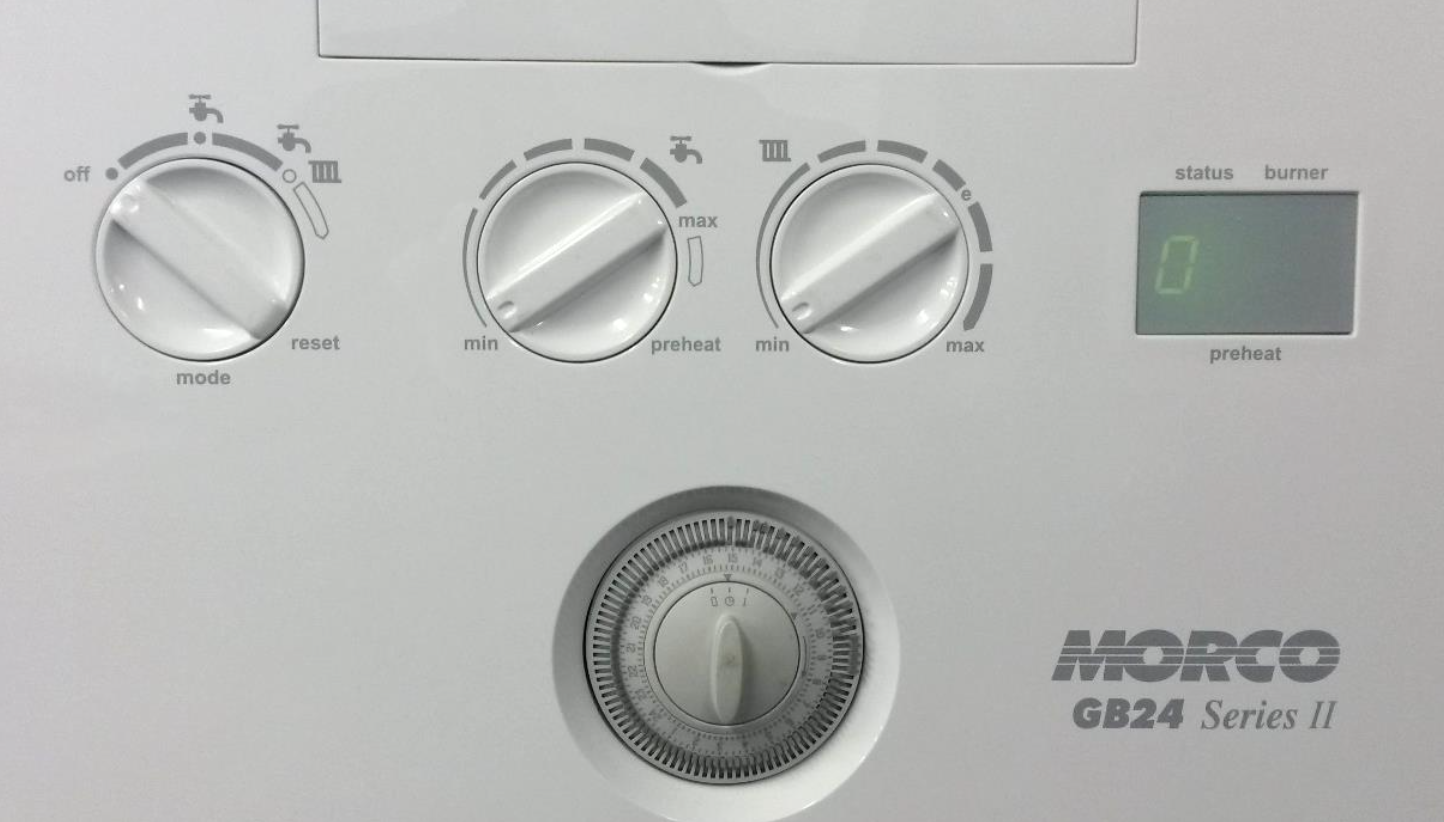
Below is a photo of the correct position for the GB24 and GB30 Series III & IV.
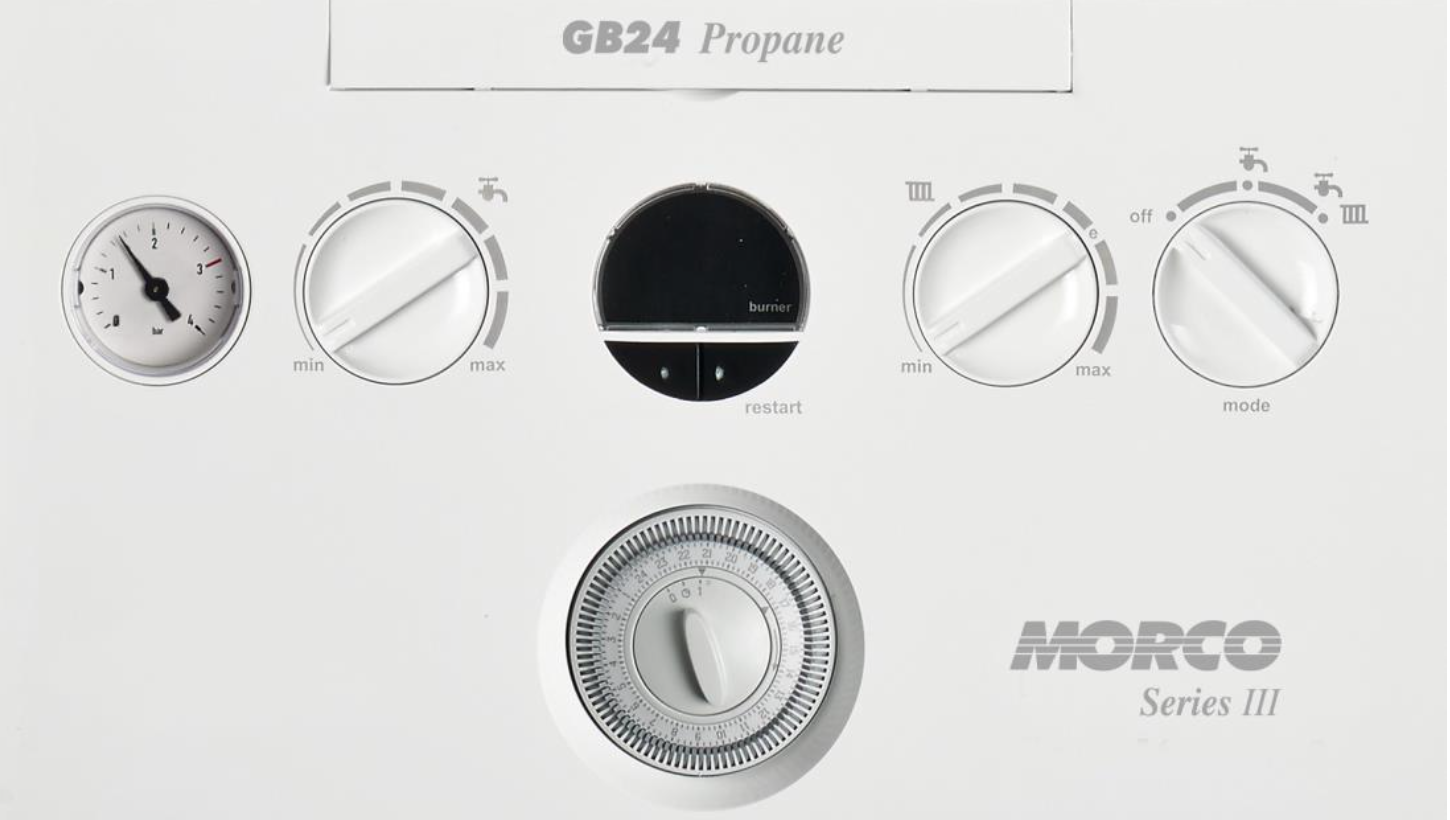
For Morco combination boilers the control knobs need setting to the off position which is fully anticlockwise*. If the boiler experiences any problems during the winter such as low system pressure or a component failure, the frost protection system will not operate.
*For the FEB20E combi boiler the frost protection system will only work with the middle control knob in the summer setting and with gas and electric connected.
Additional Information for Condensing Combination Boilers
Historically condensing boilers have been fitted to residential park homes but within the last 5 years all combination boilers supplied in caravan holiday homes have been of the condensing type. As part of the condensing process a liquid condensate is produced that leaves the boiler via a condensate trap and flows into the waste water drain under the holiday home. In certain circumstances this condensate can freeze and block the passage of newly generated condensate that in turn extinguishes the boiler and displays a fault code. There are four ways of mitigating this problem:
- The condensate trap used should be siphonic. It will store approximately 150ml of warm condensate inside the boiler and release it all at once making freezing within the pipe below less likely. Morco’s GB range of condensing boilers features a siphonic trap.
- Condensate traps can be removed from the boiler when it is not in use to avoid being damaged by frost. These must only be removed by a Gas Safe engineer. They must be replaced prior to turning the boiler on as they are an important feature of the boiler’s operation (see photo). The colour of the condensate is not green as in the photo but clear. The Morco trap in the GB24 boiler has been frost tested and has not failed so removing it is a belt and braces approach rather than a necessity.
- Ensure that the pipe that takes the condensate from the boiler to the drain is at least 22mm. Most installations will feature a 22mm pipe changing to a 32mm pipe before it passes through the floor.
- The condensate pipe work should, wherever possible, be vertical until it reaches the main 110mm waste pipe under the home. This way the condensate has the easiest possible journey. Horizontal condensate pipes will trap fluid and may freeze.
- For the FEB24 range of boilers the fault code varies:
- A6UA. This means “water” in Spanish and is telling you that water in the primary circuit cannot circulate
- Three flashing lights – FEB24E see manual
- F4 on the FEB24ED and FEB24ED3*
- For the GB range of boilers the Fault code is L1 but you may also get a C displayed permanently after a momentary blue burner light and this is telling you that the boiler has overheated as there is no circulation in the heating circuit.
- Turn the electric supply to the boiler off
- For the FEB24 range, prise off the boiler white front cover (it has 2 pop studs on each side) and drop the plastic lower panel by removing 1 or 2 screws on the front of the panel and 2 on the underside. For the GB range the process is much simpler – there is a flap between the plastic lower cover and the metal cover – simply open the flap, undo the screw/s, clip the flap closed to retain the screws. The whole plastic cover will drop down on a hinge.
- Now the pump will be visible and you will need to insert a screwdriver into the front of the pump and turn a few times to free the pump spindle.
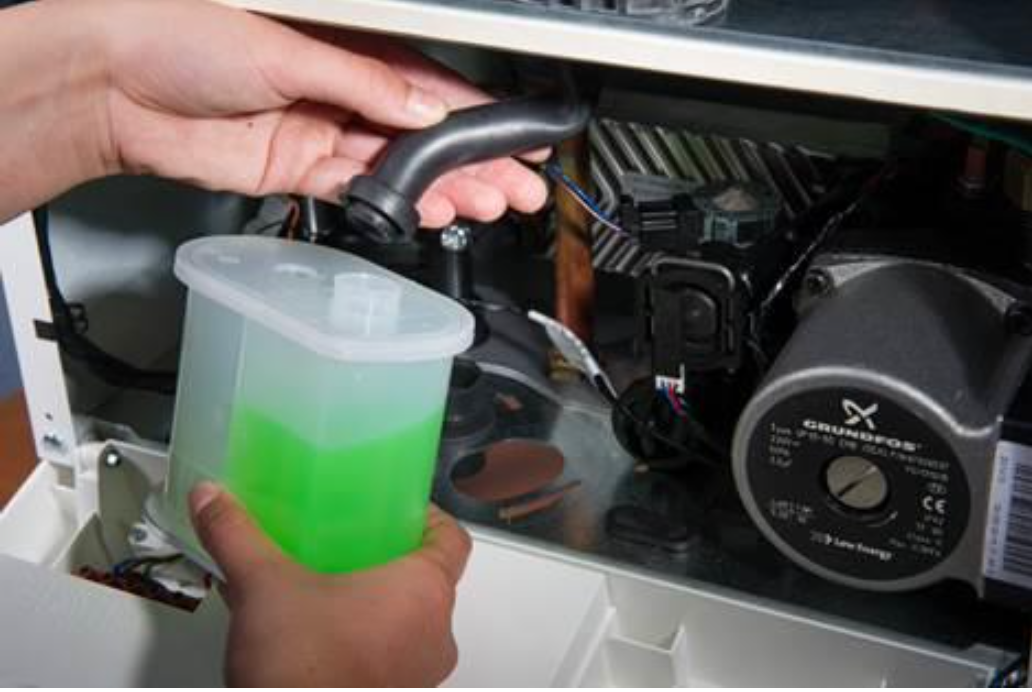
Radiator Valves
Most central heating systems have thermostatic radiator valves and these have a frost setting marked as “*”. This setting is not relevant to the protection of your caravan holiday home from frost.
Summary
The only way to guarantee protection for the fresh water circuit in your holiday home is to ask an experienced engineer to carry out a drain down using a system capable of blowing water out. The only way to guarantee protection for the sealed central heating circuit (if fitted) is to check with a refractometer that the system has sufficient antifreeze to withstand the temperatures it is likely to encounter during the winter.
Doing your own drain down and using a boiler frost protection system (where fitted) will offer some protection but frost damage is still a possibility due to the reasons outlined in the preceding sections.
Re-commissioning the Home
When you return to the home, you may experience a problem with the combination boiler that is easy to resolve. The problem is the pump that circulates water around the boiler in both hot water and central heating mode has become stuck. This happens occasionally when the pump has been inactive for a long period and when there has been no mains electric power to the home. If the home is connected to mains throughout the year the pump will switch on for a short period every day (independent of hot water or heating duties) to stop it sticking.
If your pump has stuck the boiler will lock out and display a fault code:
As the pump is only stuck and not permanently damaged, the problem can be resolved:/p>
In the case of the earlier ranges of boilers you will first need to remove a blanking nut and a small amount of water may leak out so have a cloth placed underneath the pump as shown below. Either a flat bladed screwdriver or an allen key will be needed to turn the spindle.
Please find below links to videos which show you how to free the pump for the GB ranges:
FEB24 Range
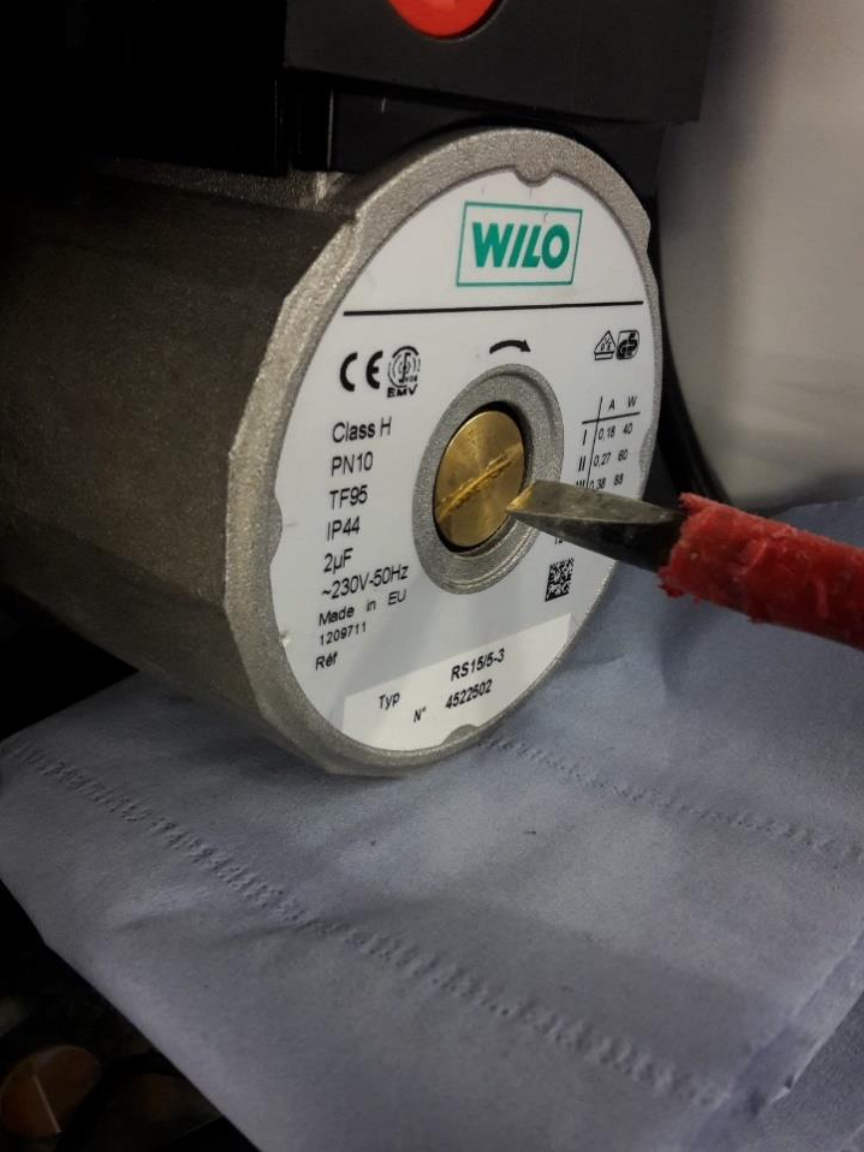

Download a copy of this help article.

